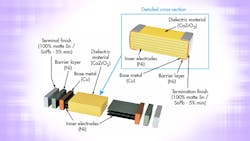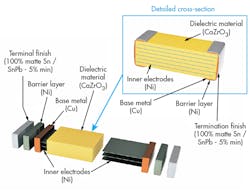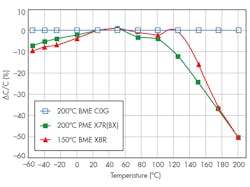This file type includes high resolution graphics and schematics when applicable.
The increasing role of electronics in modern vehicles is a well-established trend. As more electronic components populate these systems, the reliability of individual devices determines the reliability of important subsystems, and has a powerful effect on the overall vehicle-ownership experience.
Component reliability is influenced by environmental conditions, which include not only electrical stresses and high ambient operating temperatures, but also thermal cycling, freezing temperatures, high humidity, rain, ice, snow, and harsh chemicals like road salt, oil, fuel, and hydraulic fluids. Furthermore, large mechanical stresses such as vibration can compromise terminations and internal connections.
On-board electronics are expected to stand up to all of these stresses and operate reliably for the design lifetime of the vehicle, which is usually several years.
Reliability Under Stress
The harshness of the automotive environment is well understood. In “under-the-hood” applications, electronic devices like sensors are being deployed progressively nearer to the engine, transmission, and braking systems to monitor parameters such as oil condition, gear selected, and the composition of exhaust gases. Temperatures in these locations can push well past 125°C. Large electrical transients may also be present, due to the switching of large numbers of loads, including highly inductive loads such as electric motors.
These factors significantly influence the selection of capacitors, which are used extensively in sensors and electronic control units throughout the vehicle, including under the hood, for purposes such as filtering, decoupling, transient-voltage suppression, and energy storage. For such circuits, designers often turn to multi-layer ceramic capacitors (MLCCs) as a cost-effective option.
The MLCC is a non-polarized capacitor that comprises two metallic terminations, each connected to multiple inner nickel electrodes separated by a ceramic dielectric that may be a Class I, II, or III material. The terminations may consist of a base metal (e.g. copper) or a precious metal. Figure 1 shows the internal construction of a typical MLCC.
Exposure to high temperatures and electrical stresses that exceed the rated limits of the device can impair the reliability of the dielectric material. Such electrical-stress-induced degradation can be predicted with reference to the inverse power model. According to this model, the dielectric lifetime decreases with increasing electric field, owing to the forces exerted by the field on the charged atoms.
Degradation resulting from excessive temperature, on the other hand, follows the Arrhenius law. This describes an exponential trend governed by the applied temperature and the activation energy, which is a property of the material. When the devices are used within their rated limits, designers can rely on the manufacturer’s lifetime predictions, which are based on environmental testing results as well as proven reliability calculations.
The development of MLCCs for automotive applications is focused on improving dielectric properties to minimize degradation. Therefore, devices can be guaranteed to deliver satisfactory performance for the typical required design lifetime.
Dielectrics for Stable Capacitance
Care should be taken to ensure that the chosen capacitor provides the desired capacitance at the intended operating temperature. Depending on the type of dielectric, the capacitance can become reduced at high temperatures, leading to changes in frequency response. The end result is unpredictable performance of a tuned circuit, such as a filter.
C0G dielectric is a class I material. Dielectrics in this class are temperature compensating, and thus are suited for resonant circuit applications or those that require Q and stability of capacitance characteristics. These include critical timing or tuning circuits, high-current or pulse applications, and circuits where low losses are critical, as well as decoupling, bypass, filtering, transient voltage suppression, blocking, and energy storage.
It is possible to produce C0G capacitors that exhibit no change in capacitance with respect to time and voltage, and capacitance change with reference to ambient temperature as low as ±30 ppm/ºC over a wide temperature range. Such a small change can be considered negligible as far as automotive applications are concerned.
With Class II dielectrics like X7R, on the other hand, high values of capacitance can be achieved within small component dimensions. This is ideal for space-constrained automotive control units. Although there’s a measurable change in capacitance with respect to time and voltage, the change is predictable. Also, with careful attention to component design, the change in capacitance with reference to ambient temperature can be kept within ±15% from –55°C to +125°C.
These characteristics make X7R MLCCs suitable for bypass and decoupling applications, or for circuits such as window comparators, where Q and stability of capacitance characteristics aren’t critical. In applications that require greater temperature stability, buffer circuitry may be used to stabilize system behavior. Alternatively, lookup tables may be implemented in software to adjust critical constants.
For critical applications where reliability and capacitance stability at higher operating temperatures are a concern, there’s a new class of dielectric called Ultra-Stable. Devices already in the market have zero capacitance change with respect to applied, rated dc voltage, and temperature-related change of less than ±15% from –55°C up to 150°C.
For applications that must withstand the most extreme temperatures in today’s vehicles, KEMET developed a high-temperature C0G dielectric capable of ensuring consistent capacitance up to temperatures above 200°C. Figure 2 compares the capacitance change from –60°C to 200°C between high-temperature base-metal electrode (BME) C0G capacitors, precious-metal electrode (PME) X7R capacitors, and Ultra-Stable X8R capacitors.
This diagram illustrates the importance of determining the effective capacitance of a chosen device at the intended operating temperature. Depending on the dielectric technology, capacitance can deteriorate at higher temperatures. When using an X7R or X8R device, a higher nominal capacitance may be needed to ensure the required capacitance when the device is at its typical operating temperature. A device of lower nominal capacitance, and therefore physically smaller, may be selected if using a high-temperature C0G capacitor. This can allow smaller overall dimensions, which may be important to the target application.
Enhanced-Reliability Packaging
Resistance to vibration in automotive applications can also be enhanced through a combination of material selection and capacitor construction. New high-break-strength C0G materials have been developed that withstand shocks up to very high G-forces. The modulus of rupture can be more than twice that of the industry’s best X7R material.
Flex cracks resulting from excessive tensile and shear stresses generated when the printed-circuit board (PCB) is flexed, or during thermal cycling, are the primary failure mode of MLCCs. Capacitor manufacturers have addressed this challenge at the package level, with innovations such as flexible terminations that incorporate a conductive epoxy in between the metal layers of the standard termination system. The epoxy introduces pliability while maintaining terminal strength, solderability, and electrical performance.
KEMET has developed another option called Fail-Open technology, which is featured in its FO-CAP devices. Fail-Open minimizes the probability of low insulation resistance or a short-circuit condition in the event of device failure due to flexing of the PCB. The internal design of these capacitors prevents cracks propagating across counter electrodes within the device’s active area. This is the location where a crack is most likely to result in a short circuit, leading to device failure. If cracks occur, the capacitor may experience a drop in capacitance, but it prevents a possible catastrophic failure.
Alternatively, stacked capacitors that comprise two or more MLCCs, one above the other and joined by a leadframe, effectively minimize mechanical and thermal stress on individual device terminations. In addition, they provide high capacitance within the same board footprint as a single MLCC.
Leaded devices, such as radial molded MLCCs, also benefit from high tolerance to stresses that can cause failures in conventional ceramic chip capacitors. The flexibility of the leads provides strain relief, but the lead attachment must be able to withstand high operating temperatures. An example is KEMET’s C052H/C062H series of molded radial high-temperature C0G MLCCs. The devices are assembled using specially formulated solder that has a high-melting-point to ensure the integrity of all lead attachments.
Conclusion
With a broad selection of advanced high-temperature dielectrics that offer long life and stability, as well as a choice of rugged package technologies, today’s automotive electronics designers can identify MLCCs that deliver the required combination of performance, reliability, and longevity—at the right price.
Erin Burns is a Field Application Engineer for KEMET Corp.



